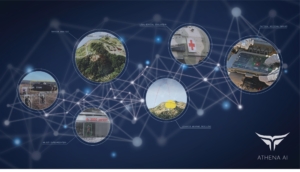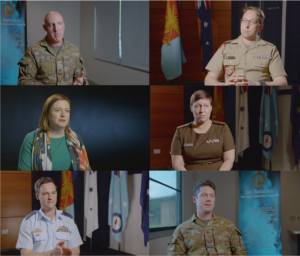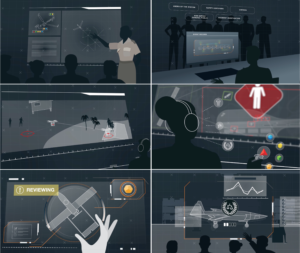Collaborating to build a better domestic and international regulatory environment for innovative autonomous vessels
By Rachel Horne, Assurance of Autonomy Activity Lead, Trusted Autonomous Systems (TAS)
Domestic and international engagement is key for understanding different regulatory, environmental, and operational contexts; providing lessons in how we might approach some of our own challenges; facilitating future collaboration; and accelerating the operationalisation of autonomous vessels nationally and internationally.
In June 2022 TAS Assurance of Autonomy Lead Rachel Horne presented at the Autonomous Ship Technology Symposium 2022 in Amsterdam and visited several UK organisations pioneering autonomous vessel development, assurance, and use. The Symposium brought together industry, defence and government stakeholders to discuss topics that included: Progressing towards Maritime Autonomous Surface Ships (MASS) adoption; legal, liability, and regulatory frameworks; vision technologies and collision avoidance; novel concepts and case studies; inland and port operations; and solving the challenges of unmanned vessels. The symposium demonstrated that industry is driving rapid technological development, but the regulatory environment and ability to integrate new and evolving technology into commercial use is not advancing at the same pace.

Rachel Horne presenting at Autonomous Ship Expo, Amsterdam June 2022 provided by Rachel Horne and Eva Szewczyk
___________________________________
Industry is driving rapid technological development, but the regulatory environment and the ability to integrate new and evolving technology into commercial use is not advancing at the same pace.
___________________________________
A panel discussion on “Legal, liability, and regulatory frameworks” highlighted this point with fundamental questions raised such as how COLREGs applies to autonomous vessels and whether the convention needs to be amended, how liability will work, and how cybersecurity should be integrated into regulatory frameworks. Combining the experience and expertise of a broad range of parties will help to answer these questions in time, highlighting the need for ongoing domestic and international collaboration. By continuing to talk to each other, organisations lower the risk of reinventing the wheel on some issues while leaving others in the “too hard” basket. How this collaboration should happen and how to make it as productive as possible is something to puzzle out together.
TAS visited leading UK institutions that are pioneering autonomous vessel development, assurance, and use. These included the Assuring Autonomy International Programme (AAIP) and the new Institute for Safe Autonomy at the University of York, the National Physical Laboratory and Smart Sound Plymouth, University of Southampton, and CEbotiX at the National Oceanographic Centre. These initiatives show an advanced state of research is well underway with frameworks and resources being developed, investment in infrastructure and facilities that foster collaborative research and development, and different types of autonomous vessels and supporting technology in use. Australia does not yet have the same level of facilities and infrastructure or the depth of experts and vessels located in close proximity to foster collaboration. Continued discussion and collaboration is vital for ongoing development when it comes to the design, assurance, regulation, and use of autonomous vessels in the future.
There are similarities with the ambitions of Australian organisations, of which many are expanding their autonomous vessel-related offerings on the side of their traditional focus areas. For example, the Australian Institute of Marine Science is pioneering the use of bespoke autonomous vessels for reef monitoring, while also building a tropical marine test range offering. AMC Search is another good example, with increasing service offerings focussed on autonomous vessel operator and technical training, while building a cold-water test range offering. The Defence and Maritime Innovation and Design Precinct being established at the University of Tasmania also shares the ambition of fostering increased science and technology capabilities by facilitating collaboration between Defence Science & Technology (DST) and academics from across the country.
TAS will release in the coming months a series of case studies that highlight the use and regulation of autonomous vessels in Australia and compare Australia’s experience with other countries such as the UK. Preparing these comparative studies, and engaging with a range of UK-based stakeholders, highlighted the difficult regulatory environment and lack of pathways for autonomous vessels, together with the barriers they create. While frustration also exists in Australia, we do have plausible pathways and regulatory initiatives underway to smooth those pathways and enable operators to get their vessels in the water. For example, TAS publication of the Australian Code of Practice and COLREGS Operator Guidance Framework stamps Australia as a world leader in progressing the regulation of autonomous vessels.

Cover pages of the Australian Code of Practice and COLREGS Operator Guidance Framework
Continued collaboration is the best way to ensure continued progress in both domestic and international regulatory frameworks. By pooling the experience, expertise and ideas of multi-disciplinary groups of stakeholders we give ourselves the best chance to mould our current regulatory frameworks to better facilitate autonomy and build new, improved frameworks. Continuing to build the literature exploring the specific and more general legal issues associated with autonomy is also crucial, and will support needed policy, legislative and convention change. Organisations such as the University of Queensland Law and the Future of War team, part of TAS’s Ethics and Law Activity, are leading research in this area, and making it accessible via initiatives such as the Law and the Future of War podcast.
There are opportunities for the Australian autonomous systems ecosystem to advocate for the change they need through both domestic and international processes. For example, domestically, the Independent Review of Domestic Commercial Vessel Safety Legislation and Costs and Charging Arrangements welcomed submissions. Both TAS and the Australian Association for Uncrewed Systems (AAUS) provided submissions to that Review focussed on changes needed to better support autonomy. The Independent Review Panel are due to provide their report to government in November 2022. At an international level, the April meeting of the International Maritime Organization Maritime Safety Committee (MSC 105) highlighted that the MSC is working to develop a goal-based instrument regulating the operation of Maritime Autonomous Surface Ships (MASS). This instrument is intended to be adopted as a non-mandatory MASS Code by 2024, with a mandatory version to be in force in 2028. AMSA represents Australia in the MSC and will need to continue to engage with the Australian autonomous systems ecosystem to ensure relevant interests are represented. You can contact AMSA through AMSAConnect (AMSAConnect@amsa.gov.au) for more information.
TAS recently facilitated a Regulatory Workshop as part of a broader Defence exercise, which brought together a broad range of Defence, Government, industry and academic participants. Reflecting on my key takeaways from the broad-ranging and insightful discussion during the event, I put forward the following key points which I think will resonate with most people working in this space:
- We must collaborate and communicate.
- For regulation to be an enabler, not an inhibitor, we need change – at a legislative, regulatory, policy, and cultural level.
- We do not need perfect; we need to iterate at we go.
- Trust is critical. We need transparency, explainability and certainty to build that trust.
- The future is now. We need to accelerate, together, to succeed.
TAS will continue to work to improve the regulatory approach to autonomous vessels and welcomes ongoing collaboration with our domestic and international stakeholders.
For those looking to connect with industry conferences and events on autonomous vessels, there are a few remaining in 2022. They include:
- Safecomp 2022, 6-9 September 2022, Munich Germany
- Ocean Autonomy Conference, 21-22 September 2022, Trondheim Norway
- Oceans Conference & Exposition 2022, 17-20 October 2022, VA USA
- Maritime RobotX Challenge 2022, 11-17 November 2022, Sydney Australia
These events offer a unique opportunity to find out what domestic and international counterparts are focussing on, to build relationships, and to set up future collaborations to ensure a thriving and trusted autonomous systems industry in the maritime domain.
If you would like to contact us to offer feedback, suggestions, or request more information on our projects, please email us at info@tasdcrc.com.au.









